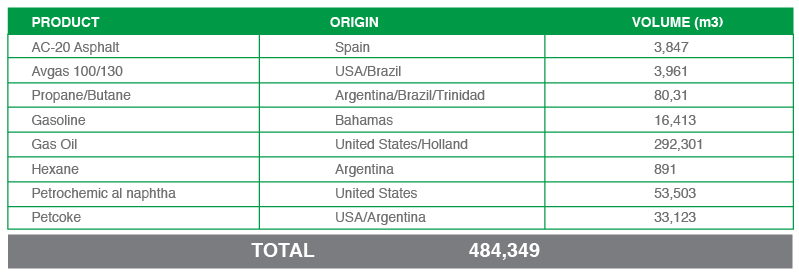1. ENERGY BUSINESSES
1.1 International fuel market
Regarding the supply of crude oil, as of the month of May we did not continue with the contract signed with PDVSA within the Energy Agreement subscribed by the Bolivarian Republic of Venezuela and the Oriental Republic of Uruguay as a result of the unavailability of light crude oil for export from Venezuela. We complemented the supply with crude oils from other origins, such as Nigeria, Brazil, and the United Kingdom.
Within the international market, 2015 showed a decrease in the price of oil compared to 2014.
The average price of the Dtd. Brent reference barrel for the year 2015 was US$ 52.5 per barrel compared to US$ 98.8 per barrel in 2014. It started the year at US$ 55.0 per barrel with a downward trend, closing the year at US$ 35.7 per barrel at the end of 2015. The prices of petroleum products followed the evolution of crude prices.
Approximately 484,350 m3 of petroleum products were imported, 171,770 m3 of which corresponded to fuels for thermal power generation. The remaining 312,580 m3 corresponded to imports to complement the internal market's demand.
The value of international ocean freights in 2015 increased when compared to the values of 2014.
Imports and exports
The supply of crude and petroleum products to the country was optimized through the diversification and broadening of markets.
The volume of crude acquired during 2015 was 14,089,000 bbls., which was more than that of 2014 (12,609,200 bbls.). It is worth noting that the rise in imports of crude was due to the fact that there were no assets under a programmed maintenance process.
The origin of the crude oil supply was: 9.2% from Venezuela, under the crude supply contract with PDVSA and the remaining 90.8 % was acquired on the spot market from Brazil (21.9 %), the United Kingdom (14.7%) and Nigeria (54.3%).
Imports of petroleum products during 2015 decreased in comparison to the previous year. This decrease was due to the fact that, in 2015, UTE's thermal centrals generated low levels of power, since the water regime and the renewable energy sources generated enough electric power. It is worth noting that, just as in previous years, part of the LPG supply during months when the demand is higher (May-September) was carried out from a floating storage. Around 42,000 m3 came into the country in this way, thus guaranteeing the supply.
We continued importing petcoke intended for ANCAP's Portland cement plants. Said petcoke arrived to the ports of Montevideo and Fray Bentos, and was then transported on trucks to the Minas, Paysandú and Treinta y Tres plants.
There were no exports during 2015 since no surplus was generated by the refinery.
Freights
With regard to activities related to shipping, during 2015 the most noteworthy activities were: a) negotiating, managing and coordinating a logistics system for the LPG product which included a "floating storage" and a lightering vessel on "time charter" dedicated to said storage, and b) hiring freights under "spot" conditions to transport crude oil, 100% of which corresponded to the Caribbean - José Ignacio route.
The following table shows the imports of crude by origin.
Crude imports for 2015

The following table presents imports of petroleum products.
Petroleum products imports for 2015

